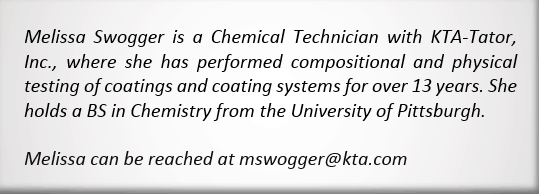Pavement marking materials are relied upon to not only to guide drivers to maintain their respective lane position to deter accidents but also for regulatory and directional purposes. Because of their functions, they must withstand many different types of wear and still perform as required. This article describes pavement marking materials including the different types available, factors affecting their performance, and the type of laboratory testing that can be performed to help predict performance.

There are four different classifications of pavement marking materials including paints, thermoplastics, two-component resins, and preformed road markings commonly referred to as tapes. Each of these is composed of three primary components: binder, pigment, and glass beads. The inclusion of glass beads is used to impart retro reflectivity, which allows light from a vehicle’s headlamps to be returned to the driver to aid visibility. The glass beads are composed of sodium silicate glass and have a refractive index between 1.5 and 1.55. They are usually broadcast onto the marking materials after application. When pavement marking materials are wet, the film of water inhibits retro reflectivity and renders them nearly invisible especially at night.
There are several performance factors that should be considered when selecting a pavement marking material, including the roadway surfaces, traffic volume, and environmental conditions. Considerations should include whether the roadway surface is smooth or rough, whether crevices are present in brick or cobblestone surfaces, and whether the road surface is heat sensitive or porous. The durability of the material is highly dependent on the daily traffic volume and the location of the lines. Typically, center and lane lines are painted yearly, and edge lines every two years. However, high traffic volume areas can require repainting up to four times a year.
Weather conditions during application is considered by some to be the most important factor in determining the performance of the marking, especially for thermoplastics and tapes. The conditions affecting application include the air and pavement temperature, the humidity, and surface moisture, all of which can greatly affect the curing of the marking material. Wind velocity primarily affects the glass bead broadcast process but can also affect the curing.
After application, the prevailing climate can also impact the long-term performance. Heavy snowfall exposes the marking materials to not only abrasion caused by snowplows but also to chemical attack from deicing materials, and solar radiation from sunlight can fade or crack marking materials. Each type of pavement marking material has advantages and limitations, but one commonality is that the pavement surface, whether hot-mix asphalt concrete, Portland cement concrete, or bituminous pavement, must be clean and dry prior to installation of the markings to achieve the desired performance.
The most widely used pavement marking material across the globe is paint. It is extremely common because it does not require heating, can be applied quickly and in warm weather, and is available in solvent-borne and water-borne formulations. Water-borne paints are the most inexpensive of all the pavement marking materials. They are environmentally friendly, are track-free sooner, and easier to handle. However, they are known to have a lower retro reflectivity value and wear more quickly, which causes them to be used more frequently in parking lots and off-road applications. While solvent-borne materials are more durable than water-borne they have a higher content of volatile organic compounds (VOCs) and are regulated by the EPA, since the solvents photochemically react during evaporation and pollute the air. In 1999 the EPA reduced the number of exempt solvents that may be used to formulate paints.
Two-component resins are composed of two chemical reactants that are mixed to produce the pavement marking material. One component contains the resin, the pigment, and any extenders or fillers, while the second component contains the activator used to cure the material. The two component resins all have a low VOC content because of the high solids content of the resin. The different resin types used are polyester, methyl methacrylate, epoxy, and polyurea. Polyester resins are 100% solids and have a free radical activator that cures the material within 15 minutes. They are applied at approximately15 mils (380 µm) wet film thickness and offer abrasion resistance and durability but can be expensive. Methyl methacrylate resins are non-hazardous and are designed to be resistant to oils, antifreeze, and other common roadway chemicals. They are highly retro reflective, bond well with the pavement surface, and can have a service life of 3 years but may last up to 10 years. They are typically applied at 40 mils (1016 µm) and do not require heat to cure. However, they must be applied slowly, require special application equipment, and require a minimum of 30 minutes to achieve full cure. Epoxy resins were first introduced as a pavement marking material in 1970. They are 100% solids, durable, and offer an extended service life of up to 5 years. They adhere well to both bituminous surfaces and Portland cement concrete surfaces and exhibit good abrasion resistance. However, they are more expensive than paints and often require longer dry times. In addition, due to color instability caused by solar radiation, they tend to fade and cannot be applied over other marking materials. Polyurea resins are relatively new and can offer a service life of up to 5 years. They have exceptional color stability, abrasion resistance, and adhesion to all types of pavements. They are less sensitive to pavement moisture, can be applied at low temperatures, and have both a faster drying time and cure time.
Thermoplastics have been used since the 1970’s to mark traffic lanes. They are applied at approximately 70 mils (1778 µm) by gravity extrusion or spray application and are solid at ambient temperatures. They do not contain solvents and can last up to 20 times longer than paint. There are two main types of thermoplastics based on either rosin esters or hydrocarbons. Rosin esters are generally more oil and solvent resistant compared to the hydrocarbon types. Advantages to using thermoplastics is the dry time and ease of re-application. Thermoplastics can be applied over older thermoplastic marking materials and perform well on all the types of pavement surfaces. The dry time for sprayed thermoplastics can be as short as one minute while the extruded can take between 2 and 10 minutes. However, they require heating prior to application because they are solid at ambient temperatures. In addition, they can be damaged or partially removed by a plow during snow removal due to their high film build.
The fourth type of pavement marking material, tapes, are well suited for severe conditions that might require frequent replacement. Preformed tapes have no drying or curing times, require little equipment for application, and the roadway can be opened to traffic almost immediately after application. The tapes have an adhesive backing. The permanent tapes can have a service life of up to one year. The temporary tapes are meant for short-term applications and are often used in conjunction with permanent raised markers. They exhibit good durability and abrasion resistance when applied to existing pavement, rolled onto hot surfaces, or grooves. However, they exhibit better performance on bituminous asphalt compared to Portland cement concrete and have a significantly higher set-up cost.
Many factors, some described above, should be considered prior to selecting a pavement marking material. First and foremost, state and/or local regulations should be consulted to determine if the use of any of the four types of materials, specifically solvent-borne paints, has been regulated due to environmental and worker exposure concerns. After selecting the appropriate pavement marking system there are a few reference standards that can be used to evaluate the comparative performance properties of candidate products.
ASTM D2205, “Standard Guide for Selection of Tests for Traffic Paints” covers the selection and use of procedures for testing traffic paints in both the laboratory and in the field. This guide focuses on tests for ready-mixed solvent base and waterborne materials of sprayable consistency. The standard categorizes the testing into several areas normally of concern when evaluating pavement markings, including liquid paint properties, application and appearance properties, properties of the dried film, paint composition, field evaluations, and field sampling. The typical testing includes density (weight per gallon), fineness of (pigment) dispersion, consistency, no-pickup time, bleeding, hiding power, reflectance, color difference, wear resistance, and nonvolatile content.
Another specification that is widely referenced for acrylic waterborne airfield and traffic marking paint is Federal Specification TT-P-1952F. This specification classifies paint into three types: Type I (for use under normal conditions), Type II (for use under adverse conditions), and Type III for increased durability. Included within the specification are qualitative requirements that the material must meet to be used, which helps the user know that the material will perform as required and helps with product selection.
The routine tests performed in the laboratory on pavement marking materials are percent weight and volume solids content, no-pickup time, color reflectance and percent pigment content. The no-pickup time testing is performed at both 40°F and 70°F and the percent pigment is quantified for the concentrations of rutile and anatase titanium dioxide.


